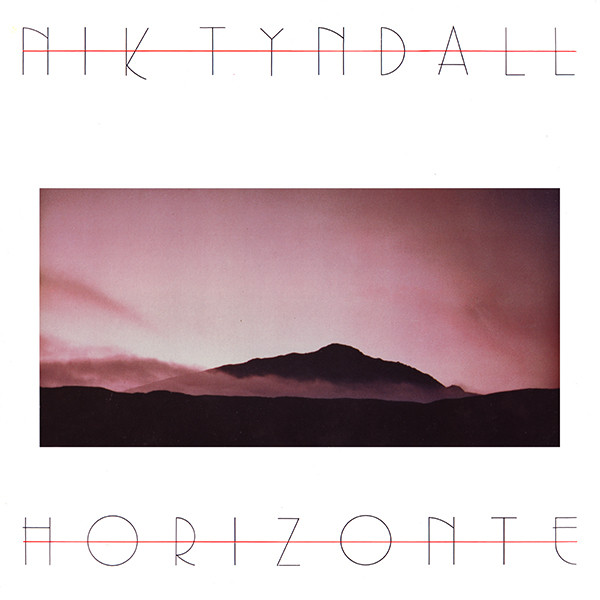
I’ve got to come clean: I’m one of those people that loves to wake up early. I feel that the hours of dawn reveal something precious that’s appreciated by relative few. It’s minutes and moments of atmospheric, environmental drama outside one’s window. Perhaps, an especially jaw-dropping sunrise. Perhaps, bird and insect song that’s less obstructed by other sounds. As a musician, it’s at that time, I’ve felt most inspired to turn on an instrument – in my case an ASM Hydrasynth – and simply live in the moment, eking out a melody or a sound that lives in that fleeting moment. Listening to Nik Tyndall’s Horizonte, it brings me back to this feeling, surmising why choosing the right tool to create is as important as the creation itself.
Jürgen “Nik” Tyndall’s story began in Stuttgart, West Germany, where an early infatuation with the early German kosmische musik of pioneering artists like Tangerine Dream, Klaus Schulze, Kluster and others, led him to explore musical synthesis and audio production. By the late ‘70s, Nik would team up with friend Rudolf “Rudi” Langer, move to West Berlin and try their hand on their own take on the “Berlin School” of musical minimalism.

In the beginning this duo, then known as Tyndall, would originate as live performers, trucking along huge modular systems to perform their spacey concerts across Germany. Soundtrack commissions would then dovetail to personal works. In due time, they’d sign on to the now, iconic Hamburg-based Sky Record label, releasing four albums from 1980-1983 that sounded like stylistic (if a bit outdated) hommages to their early electronic heroes. So, it came as no surprise that Nik in 1983 sought some kind of change in his career.
Dissolving the duo and adopting the new stage name of Nik Tyndall, Jürgen began to explore new venues that were appearing before his eyes. Inspired by the nascent New Age movement, Jürgen tried to move away from the “old” way of creating.
If ever you’ve laid your hand on a Eurorack or modular system, you’ve likely felt that same predicament Nik experienced. Although great for exploring a sound, those huge electronic music synthesizers couldn’t be further from the immediate intimacy of other instruments. Jürgen had already lost his way in sound, he wanted to get back to simply making music.
It was with the introduction of Wolfgang Palmer’s pioneering creation, the PPG Wave music synthesizer, that allowed Jürgen to rethink his approach to music. Here was something instant and immediate. A PPG Wave synthesizer, unlike “analog” synthesizer instruments, differed by providing more immediate ways to create a sound.
In the past, subtractive synthesizers from the likes of Moog and ARP required you to start with a small selection of sound generators and use myriad filters, modulation devices, and volume modules to try to sculpt a tone. Additive-style electronic instruments, like organs or the cost-prohibitive Fairlight CMI sampler/synthesizer would use multiple added iterations of the same sound to create a new, differing, one.
Other popular synths of the early ‘80s like the Yamaha DX7, a frequency-modulating synth, held promise but required insane patience to master and create sounds with (as one sound source would modulate another sound source, imbibing it a distinct way of sound-sculpting many musicians weren’t used to using). The PPG Wave was different, though.
With a PPG Wave, a library of base sounds in its brain, so-called “wavetables”, would allow a user to instantly bring up and select mallet, brass, or vocal/vowel-style instruments, for example, and use myriad, immediate parameters to reimagine those sounds inside out. That it could free a whole wall of gear with just one tidy instrument, would make it a boon. No more time-wasting creating sounds, you had a starting point now. It would be of no surprise that elite synthesists and electronic musicians would gravitate to this instrument for these reasons alone.
1985’s Entspannung would give listeners a new taste of the tonal music Nik could create with his PPG Wave. Warmer-sounding, less “busy” and more ethereal, this relaxation music marked a turning point in Nik’s musical aesthetic and presented him an entry into the new world of ambient music. Just a year later, 1986’s Einklang, rightfully, cemented the fruits of his newfound exploration of wavetable synthesis.
Harmonious, just like the title, Einklang used long-form music to present a moving musical meditation that could draw out a lot of the warm, beautiful, and otherworldly, tones possible from his chosen instrument. Songs like “Sehnsucht”, “Havel”, and the title track still have a way to worm their way into your mind with sounds that are simply dreamlike.
My pick of Nik’s new blissful stasis would occur just later that year with Horizonte. Just as before, Nik would split the record into two sides. On the A-side you’d get immediate, short songs that held a certain regal quality to them, that had a sonic palette that fit the “music for meditation” mold easily. The B-side would, once again, hold just one side-long track that hovered in just a way that fit the album cover’s majestic mystery.

The quasi-acoustic title track, “Horizonte”, would approximate the reverential tone of timeless chamber music. Real and imagined environmental soundscapes speak through a track like “Mediterranean Summer”. “Wannsee” uses counterpoint and Euclidean rhythms to capture, then reimagine, a hypnotic vignette of music.
It still boggles my mind that of the many Sky releases this album seems to be one of those that remains a bit forgotten. I’m listening to “Far Out” and marveled by its spatial intelligence and (sonic) heart. Songs like the ornate and haunting “Insel der Ruhe” may now exist out of style but nuggets of new music exist in the tool Nik chose to create this wonderful album. As always, streams leading to coves of singular stuff. Perhaps more times like these require instant music, much like this?
